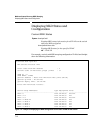
7-6
Multicast Listener Discovery (MLD) Snooping
Introduction to MLD Snooping
A network node establishes itself as an MLD host by issuing a multicast “join”
request (also called a multicast “report”) for a specific multicast address when
it starts an application that listens to multicast traffic. The switch to which the
node is connected sees the join request and forwards traffic for that multicast
address to the node’s port.
Queries. The querier is a multicast router or a switch that periodically asks
MLD hosts on the network to verify their multicast join requests. There is one
querier for each VLAN, and all switches on the VLAN listen to the responses
of MLD hosts to multicast queries, and forward or block multicast traffic
accordingly.
All of the ProCurve switches described by this guide have the querier function
enabled by default. If there is another device on the VLAN that is already acting
as querier, the switch defers to that querier. If there is no device acting as
querier, the switch enters an election state and negotiates with other devices
on the network (if any) to determine which one will act as the querier.
The querier periodically sends general queries to MLD hosts on each multicast
address that is active on the VLAN. The time period that the querier waits
between sending general queries is known as the query interval; the MLD
standard sets the default query interval to 125 seconds.
Network nodes that wish to remain active as MLD hosts respond to the queries
with join requests; in this way they continue to assert their presence as MLD
hosts. The switch through which any given MLD host connects to the VLAN
sees the join requests and continues forwarding traffic for that multicast
address to the MLD host’s port.
Leaves. A node acting as an MLD host can be disconnected from a multicast
address in two ways:
■ It can stop sending join requests to the querier. This might happen if the
multicast application quits or the node is removed from the network. If
the switch goes for slightly more than two query intervals without seeing
a join request from the MLD host, it stops sending multicast traffic for that
multicast address to the MLD host’s port.
■ It can issue a “leave” request. This is done by the application software
running on the MLD host. If the MLD host is the only node connected to
its switch port, the switch sees the leave request and stops sending
multicast packets for that multicast address to that port. (If there is more
than one node connected to the port the situation is somewhat more
complicated, as explained below under “Fast leaves and forced fast
leaves”.)


















